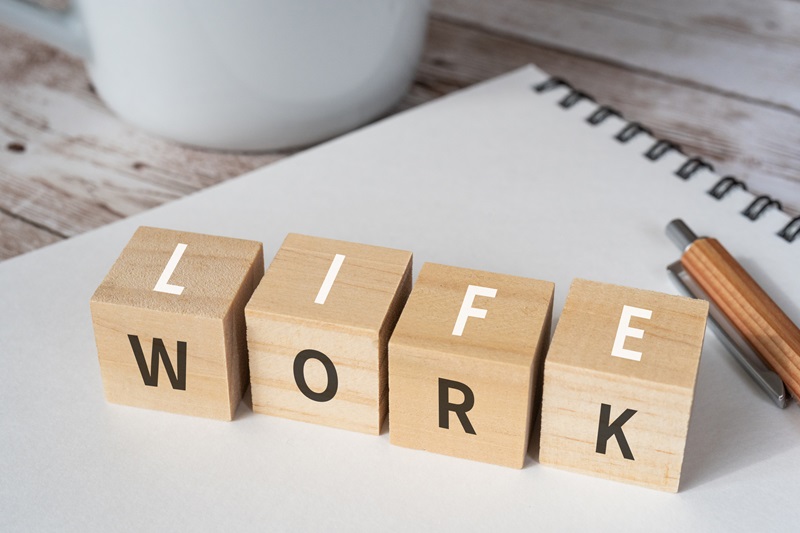We live in a fast-paced culture that values hard work and dedication above almost everything else. The common belief is that you must work longer and harder than anyone else if you want to get ahead or even just to keep up. But research shows that when work takes up all your time, your well-being may be undermined and relationships with other people in your life can suffer.
A healthy work-life balance helps to keep your stress levels under control, ensures you stay fresh on the job, protects your body and mind, and allows you to enjoy the fruits of your labor. We’ve put together this collection of tips for work-life balance to give you the strategies you need to manage the demands of your job while having time for the other joys that life offers.
What is Work-Life Balance?

Most of us need jobs to pay for our essential living expenses, but for many, the pursuit of careers and opportunities for advancement can create a demand to spend more and more time and energy working to achieve those goals.
Some occupations, such as healthcare work or law enforcement, require a greater time and emotional commitment. These circumstances can consume so much of your focus and energy that you have little or none left for a social life, leisure activities or even to take care of your own needs.
The challenge is to give your best effort while you’re working and then to feel free to devote the rest of your time to what’s important to you personally without worrying about your job. That is, you want to strike a balance between the demands of work and the pleasures of life.
Almost everybody wants this sort of work-life balance, but it doesn’t mean the same thing for everyone. Many people prefer a job that starts and ends at set times and there is no expectation for working beyond that schedule. Others favor a position with flexible hours that allow employees to plan their days around their own preferences.
Remote work can make it easier to juggle the demands of your daily life but it can easily blur the lines between your professional and personal lives, making it hard to keep them balanced. Parents of young children often value the chance to attend school-day events, while single people may prefer intense periods of work followed by time to travel.
Whatever your choice, the goal of work-life balance is to keep your job from dominating all your time.
How can you tell when your work and personal lives are out of balance? Here are a few of the most noticeable signs.
Doing Just One Thing
The persistent urge to just log in and take care of a task or send emails outside of the standard work hours may seem harmless, but it strongly tilts the balance in the direction of your job.
Always Talking About Work
Are all or even most of your conversations about your job? That indicates you are too locked into your work and have not created space for other topics and interests.
Loss of Sleep and Chronic Fatigue
If you have trouble falling or staying asleep, especially during busy periods at work, or feel tired even when you’re getting enough sleep, the stress from your job may not allow you to get sufficient rest.
Eating While Working
Mealtimes are an important break in your day that bring you nourishment, enjoyment and, ideally, companionship with others. When you eat while you work, you are more likely to make unhealthy food choices or skip meals. That makes it harder for you to eat well and maintain your healthy weight.
Anxiety and Distraction
Concern is normal when you care about your work, but chronic worrying can turn into anxiety, with your thoughts consumed by what you haven’t done or what could go wrong. This is not only unhealthy for you, but you probably aren’t giving your full attention to other people or taking care of your overall well-being.
Strategies for Enhancing Work-Life Balance

Setting Clear Boundaries
Take the initiative in defining your work life by considering what helps you to maintain your mental and physical well-being and making sure you consistently have time for them. This requires clear communications with your co-workers.
For instance, if you benefit from a midday walk, block off that time on the calendar and let others know you aren’t available for meetings and calls.
You may decide that responding to emails and direct messages is overwhelming your time away from work. Set up auto-responses that let others know when you will reply. The key is to be proactive and transparent.
Time Management Techniques
The more efficiently you work, the more you will accomplish and the more time you have for yourself. Begin by ranking the tasks you need to do by urgency and importance, and tackle those that are both urgent and important first.
Look at the tasks you’ve categorized as urgent but unimportant and ask yourself if they truly need to be done now and by you. Chances are, you can skip some or all of them. When you can, pay attention to the tasks that are important but less urgent. In many cases, those can make the most difference in your success, but you need to find time for them by dropping less impactful work.
Procrastination sucks up the time you want for yourself without reducing the pressure to get work done. To keep yourself on task, mute all the notifications on your phone and other devices except for emergencies from key people.
Break your big tasks into smaller steps and set goals for completing them. You might decide, for instance, that you will finish one page in a report in the next 20 minutes. When you’ve reached the goal, stop for a couple minutes and look away from your work. Then set your goal for the next step and get to it.
Scheduling your own time, if you are able, can be a powerful aid in keeping you focused on your work. Say you are most productive first thing in the morning or right after lunch. Block off that time for your most challenging work. Leave other times of the day for jobs that you can do more quickly.
Tools and Technology
We are now more accessible than ever before, which can make it easy for work to intrude on your life. But technological tools can also help you to get more done without asking more of your time.
Think about tasks you need to do every day or week that might be automated such as gathering data into a report. Most smartphones have timer apps you can use to stay on task and, just as important, remind you when it’s time to stop working.
Personal Well-Being and Work-Life Balance

Regular Exercise
Daily activity is critical for reaching and maintaining your health goals, and it is a simple yet highly effective way to relieve stress when the demands of work are overwhelming. Just 30 minutes of movement a day will burn calories, help your heart stay healthy and strong, and tone your muscles, too.
Exercise reduces the levels of stress hormones, including adrenaline and cortisol, in your body. It stimulates the production of endorphins, compounds that are natural painkillers and mood elevators. You get these benefits from at least a half hour of activity, but you don’t have to do the 30 minutes all at once. If your job allows only 10-minute breaks during the day, you can do your exercise in three separate sessions.
Walking is an easy and convenient exercise, but it’s not your only choice. You can do calisthenics, such as jumping jacks and deep knee bends, or strength training with light weights just about anywhere. Yoga stretches help you to stay flexible and increase blood flow to all parts of your body, so you stay more alert and relaxed.
Or forget about working out altogether and get your boogie on. Dance like no one is watching to a couple of your favorite songs and you will get your heart pumping and your mood improved.
Mindfulness and Meditation
You also can relieve stress and take a break from work by doing nothing. Well, not exactly nothing, but rather shifting your attention away from your to-do list and focusing on how you feel.
Mindfulness and meditation are practices that let you relax and let go of tension while helping you connect to your inner self. You can find handy apps that guide you through meditation and help you to direct your thoughts as you go through the process.
Many practitioners of meditation set a specific time for it each day. However, you can try it whenever you are feeling stressed out. Tai chi is a form of moving meditation that you can do just about anywhere.
Hobbies and Downtime
What you do in your time away from work plays an important role in refreshing your mind, body and spirit. Active hobbies, such as golf, pickleball or bicycling, are healthy exercise that also take your thoughts off your job. Hiking, gardening and other outdoor activities bring you into nature where the sights, sounds and scents can revitalize you.
For many people, making art or crafts is soothing and offers a sense of accomplishment outside of work. Playing music or simply singing along to songs you like relieves tension for many.
All of us need a little time each week to do nothing demanding. For some, that is watching TV or scrolling through social media feeds.
Reading may be an even more rewarding way to spend your downtime. While reading can seem like a school assignment for many people, there is such a wide range of book choices available that almost everyone can find some that engage their interest.
Navigating Professional Demands

Learning to Say No
The biggest challenge for many working people is to fend off constant requests for you to take on more. But protecting your work-life balance often requires turning some of them down.
When you need to say no to a co-worker or even a manager, you can be both firm and helpful. First, express gratitude for the opportunity and then be clear and concise about declining to take it on. Don’t waffle or offer excuses. Just say, “I can’t do what you’re asking.”
Second, offer solutions or alternatives. You could say, for instance, “I’d be glad to do what you are asking, but it will have to wait until I have other priorities handled” or “I would be happy to help with one part of the job if you or someone else can take on others.”
Negotiating Workload and Flexible Hours
Finding and retaining quality workers is an ongoing challenge in today’s labor market. That gives you some leverage once you’ve established yourself at a job. With that in mind, you can approach your supervisors to discuss your workload and flexible scheduling.
In this conversation, emphasize that you are a reliable employee who can be counted on to complete assignments on time and correctly. Explain how work-life balance is essential to your well-being and that granting your request for a manageable workload and flexible hours will ensure that you come in well-rested and able to devote your full energy to the job.
Make it clear that you understand every job has crunch times when you might need to work a little longer than normal and that you will be prepared for that so long as it doesn’t become a chronic condition of the job.
Use Your Vacation Time
Employers offer staff vacation time because they know it helps recharge workers. However, many hard-driving people don’t take advantage of time off because they fear they will fall behind or miss opportunities. In fact, Americans have on average 9.5 unused vacation days at left at the end of the year, according to Human Resources Director magazine.
Some companies allow employees to roll over their leftover time off into the next year, but many don’t. Use your vacation time to help sustain your work-life balance, even if you don’t have plans to go anywhere. Take the time for day trips or just to relax.
Take Breaks!
In addition to time off, you also need breaks during the workday. If you push through work when your energy is flagging, you are more likely to make mistakes and be inefficient with your time.
Every two hours, take five to 10 minutes to stop working, stretch or otherwise move around, have a healthy snack, or just let your mind wander. When you come back, you will feel refreshed and ready to get back on task.
Work-life balance can seem like an unattainable goal when you have a job with constant demands, but it is essential to your health and well-being that you find time for self-care and leisure. You can use the strategies discussed here to define boundaries for yourself and your co-workers, set up a schedule that fits with your needs, and fit in activities that support your goals. Work-life balance may not mean the same thing to everybody, but we all need and deserve it.
The post Work-Life Balance Tips That Actually Work appeared first on The Leaf.
Comments
Post a Comment